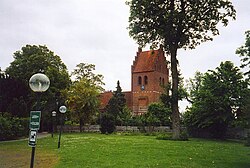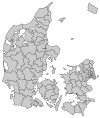Gladsaxe Municipality
Gladsaxe Municipality
Gladsaxe Kommune (Danish) | |
|---|---|
 Gladsaxe Church in Gladsaxe | |
 | |
| Coordinates: 55°44′00″N 12°29′00″E / 55.7333°N 12.4833°E | |
| Country | Denmark |
| Region | Hovedstaden |
| Established | 1 April 1909 |
| Seat | Gladsaxe |
| Government | |
| • Mayor | Trine Græse (S) |
| Area | |
• Total | 25 km2 (10 sq mi) |
| Population (1. January 2024)[1] | |
• Total | 70,600 |
| • Density | 2,800/km2 (7,300/sq mi) |
| Time zone | UTC+1 (CET) |
| • Summer (DST) | UTC+2 (CEST) |
| Municipal code | 159 |
| Website | www |
Gladsaxe Municipality (Danish: Gladsaxe Kommune) is a municipality (Danish, kommune) near Copenhagen in Region Hovedstaden on the island of Zealand (Sjælland) in eastern Denmark. The municipality covers an area of 25 km2 (10 sq mi), and has a total population of 70,600 (2024). Its mayor is Trine Græse, a member of the Social Democrats (Socialdemokraterne) political party.
The site of its municipal council is the town of Buddinge. Other towns in the municipality are Gladsaxe, Bagsværd, Mørkhøj and Søborg —but town limits are not distinguishable because the towns have grown together in an urban sprawl. Mørkhøj, Værebro in Bagsværd and Høje-Gladsaxe are larger housing projects and home to many immigrants and being typical for many concrete highrise suburbs in Copenhagen. Picture of Gladsaxe Heights:[1][permanent dead link]
At Gladsaxe, there is a 206.5-metre-tall (677 ft) guyed TV mast, which was built in 1955. It was the first TV transmission site in Denmark.
Since 2014, Gladsaxe has been home to Copenhagen gem and mineral show, the largest gem and mineral show in Scandinavia. The show is an annual two-day event that attracts exhibitors from all around the world and an audience of thousands from Denmark and Sweden.
Gladsaxe municipality was not merged with other municipalities by 1 January 2007 as the result of nationwide Kommunalreformen ("The Municipal Reform" of 2007).
Economy
[edit]Gladsaxe municipality is home to many company headquarters, including those of Novo Nordisk, Novozymes and Scandinavian Tobacco Group and MT Højgaard.
History
[edit]This section needs expansion. You can help by adding to it. (November 2023) |
According to Gladsaxe-bogen I (which focuses on then Gladsaxe-Herlev municipality up until 1909) by C.L.B. Cramer, humans first settled in Gladsaxe around 10.000 years ago.[2]
In 1670 the parishes of Gladsaxe and Herlev became "rider districts", and every farm had to house a rider/soldier or pay 48 rigsdales yearly. Cramer described "these years as probably some of the most uneasiest years in the parishes long history". In the 1720s the king built a school for riders in Gladsaxe, and his sister, Sophie Hedevig, built a school in Bagsværd. These were the first schools in Gladsaxe.[2] In 1750, Gladsaxe Præstegaard burns down, along with some farms, with many people losing their lives.[2]
In 1945, Søborg School was used to accommodate 500 German refugees, meaning students at that school instead were educated at Marielyst School. This caused the school hours to be reduced from 50 to 40 minutes, with half the students meeting from 8 to 13 o'clock and the other half from 13 to 18 o'clock. In November of that year the refugees could move in at a badminton hall by Gladsaxev Street due to renovations providing room division and heating.[3]
During the 1960's and up until the 2000's, the headquarters of Denmarks Radio, the national broadcaster of Denmark, were located in Gladsaxe.
In 1977-78, a 19-year-old student from Gladsaxe known as "Bombemanden" (The bomb man) was known for placing pipe bombs in public areas in Copenhagen, such as phoneboxes, hurting four although killing no one.[4]
In 1980, a library, Gladsaxe Hovedbibliotek, opened right by the town hall square, becoming the head library of Gladsaxe.[5]
In 1994, a McDonalds restaurant opened by the Buddinge Center.[6]
Parks and open spaces
[edit]Park and green spaces in Gladsaxe Municipality include Aldershvile Slotspark, Bagsværd Fort Folkepark, Bagsværd Sø, Bagsværd Søpark, Gladsaxe Fort Gyngemosen og Høje Gladsaxe Park, Kagsåparken, Nybro Åmose, Radiomarken and Smør- og Fedtmosen.[7]
Almost every year, if not every year, there is a day called ''Gladsaxe Day'' (Gladsaxedagen in Danish), where people in Gladsaxe come together and celebrate.[8]
Politics
[edit]Municipal council
[edit]Gladsaxe's municipal council consists of 25 members, elected every four years.
Below are the municipal councils elected since the Municipal Reform of 2007.
| Election | Party | Total seats |
Turnout | Elected mayor | |||||||||
|---|---|---|---|---|---|---|---|---|---|---|---|---|---|
| A | B | C | F | I | O | V | Ø | ||||||
| 2005 | 11 | 1 | 2 | 2 | 2 | 4 | 3 | 25 | 66.3% | Karin Søjberg Holst (A) | |||
| 2009 | 9 | 1 | 3 | 5 | 2 | 4 | 1 | 62.7% | |||||
| 2013 | 10 | 1 | 1 | 2 | 1 | 3 | 4 | 3 | 68.4% | ||||
| 2017 | 10 | 2 | 1 | 2 | 2 | 5 | 3 | 65.7% | Trine Græse (A) | ||||
| 2021[note 1] | 8 | 2 | 3 | 3 | 1 | 4 | 3 | 62.4% | |||||
| Data from Kmdvalg.dk 2005, 2009, 2013, 2017 and 2021 | |||||||||||||
Twin towns – sister cities
[edit] Charlottenburg-Wilmersdorf (Berlin), Berlin, Germany
Charlottenburg-Wilmersdorf (Berlin), Berlin, Germany Gagny, France
Gagny, France Haabersti (Tallinn), Estonia
Haabersti (Tallinn), Estonia Klagenfurt, Austria
Klagenfurt, Austria Koszalin, Poland
Koszalin, Poland Minden, Germany
Minden, Germany Narsaq, Kujalleq, Greenland
Narsaq, Kujalleq, Greenland Neubrandenburg, Germany
Neubrandenburg, Germany Paisley, Scotland, United Kingdom
Paisley, Scotland, United Kingdom Pirkkala, Finland
Pirkkala, Finland Ski, Norway
Ski, Norway Solna, Sweden
Solna, Sweden Split, Croatia
Split, Croatia Sutton, England, United Kingdom
Sutton, England, United Kingdom Taitō (Tokyo), Tokyo, Japan
Taitō (Tokyo), Tokyo, Japan Veszprém, Hungary
Veszprém, Hungary
Notable people
[edit]

- Nancy Eriksson (1907–1984), Swedish politician and a member of the Swedish Riksdag
- Thomas Rørdam (born 1952), lawyer, President of the Supreme Court of Denmark
- Mette Bock (born 1957), political scientist, journalist and politician
- Allan Steen Kristensen (1958–1997), criminal
- Thomas Bo Larsen (born 1963), actor
- Lars Mikkelsen (born 1964), actor
- Jonatan Spang (born 1978), standup comedian, actor and theatre director
Sport
[edit]- Frederik Hansen (1885–1981), wrestler
- Per Frimann (born 1962), footballer
- Peter Schmeichel MBE (born 1963), footballer
- Bo Spellerberg (born 1979), handballer
- Chanan Colman (born 1984), Danish-Israeli basketball player
- Louise Mai Jansen (born 1984), swimmer
- Daniel Wass (born 1989), footballer
References
[edit]- ^ BY2: Population 1. January by municipalities The Mobile Statbank from Statistics Denmark
- ^ a b c Cramer, C.L.B. (1949). Gladsaxe-bogen I (in Danish).
- ^ "1940-1949 – Gladsaxe Lokalhistoriske Forening". www.gladsaxelokalhistorie.dk. Retrieved 3 November 2023.
- ^ "1970-1979 – Gladsaxe Lokalhistoriske Forening". www.gladsaxelokalhistorie.dk. Retrieved 3 November 2023.
- ^ "1980-1989 – Gladsaxe Lokalhistoriske Forening". www.gladsaxelokalhistorie.dk. Retrieved 3 November 2023.
- ^ "1990-1999 – Gladsaxe Lokalhistoriske Forening". www.gladsaxelokalhistorie.dk. Retrieved 3 November 2023.
- ^ "Parker og naturområder" (in Danish). AOK. Archived from the original on 5 December 2013. Retrieved 21 January 2014.
- ^ "Gladsaxedagen". gladsaxe.dk. Retrieved 14 April 2021.
- ^ "Venskabsbyer". gladsaxe.dk (in Danish). Gladsaxe Kommune. Retrieved 15 April 2021.
Notes
[edit]- ^ One seat went to Lokallisten Gladsaxe, a local party.
External links
[edit]- Municipality's official website
- [2]
- Municipal statistics: NetBorger Kommunefakta, delivered from KMD aka Kommunedata (Municipal Data)
- Municipal mergers and neighbors: Eniro new municipalities map
- List of parks and open spaces


